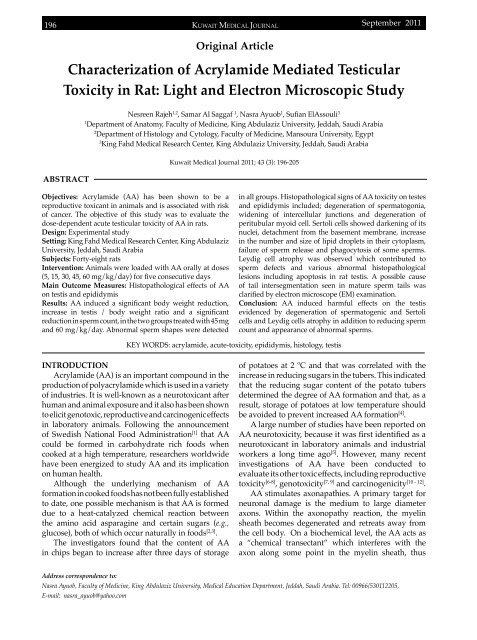Vol 43 # 3 September 2011 - Kma.org.kw
Vol 43 # 3 September 2011 - Kma.org.kw
Vol 43 # 3 September 2011 - Kma.org.kw
You also want an ePaper? Increase the reach of your titles
YUMPU automatically turns print PDFs into web optimized ePapers that Google loves.
196<br />
KUWAIT MEDICAL JOURNAL<br />
<strong>September</strong> <strong>2011</strong><br />
Original Article<br />
Characterization of Acrylamide Mediated Testicular<br />
Toxicity in Rat: Light and Electron Microscopic Study<br />
Nesreen Rajeh 1,2 , Samar Al Saggaf 1 , Nasra Ayuob 1 , Sufian ElAssouli 3<br />
1<br />
Department of Anatomy, Faculty of Medicine, King Abdulaziz University, Jeddah, Saudi Arabia<br />
2<br />
Department of Histology and Cytology, Faculty of Medicine, Mansoura University, Egypt<br />
3<br />
King Fahd Medical Research Center, King Abdulaziz University, Jeddah, Saudi Arabia<br />
ABSTRACT<br />
Kuwait Medical Journal <strong>2011</strong>; <strong>43</strong> (3): 196-205<br />
Objectives: Acrylamide (AA) has been shown to be a<br />
reproductive toxicant in animals and is associated with risk<br />
of cancer. The objective of this study was to evaluate the<br />
dose-dependent acute testicular toxicity of AA in rats.<br />
Design: Experimental study<br />
Setting: King Fahd Medical Research Center, King Abdulaziz<br />
University, Jeddah, Saudi Arabia<br />
Subjects: Forty-eight rats<br />
Intervention: Animals were loaded with AA orally at doses<br />
(5, 15, 30, 45, 60 mg/kg/day) for five consecutive days<br />
Main Outcome Measures: Histopathological effects of AA<br />
on testis and epididymis<br />
Results: AA induced a significant body weight reduction,<br />
increase in testis / body weight ratio and a significant<br />
reduction in sperm count, in the two groups treated with 45 mg<br />
and 60 mg/kg/day. Abnormal sperm shapes were detected<br />
in all groups. Histopathological signs of AA toxicity on testes<br />
and epididymis included; degeneration of spermatogonia,<br />
widening of intercellular junctions and degeneration of<br />
peritubular myoid cell. Sertoli cells showed darkening of its<br />
nuclei, detachment from the basement membrane, increase<br />
in the number and size of lipid droplets in their cytoplasm,<br />
failure of sperm release and phagocytosis of some sperms.<br />
Leydig cell atrophy was observed which contributed to<br />
sperm defects and various abnormal histopathological<br />
lesions including apoptosis in rat testis. A possible cause<br />
of tail intersegmentation seen in mature sperm tails was<br />
clarified by electron microscope (EM) examination.<br />
Conclusion: AA induced harmful effects on the testis<br />
evidenced by degeneration of spermatogenic and Sertoli<br />
cells and Leydig cells atrophy in addition to reducing sperm<br />
count and appearance of abnormal sperms.<br />
KEY WORDS: acrylamide, acute-toxicity, epididymis, histology, testis<br />
INTRODUCTION<br />
Acrylamide (AA) is an important compound in the<br />
production of polyacrylamide which is used in a variety<br />
of industries. It is well-known as a neurotoxicant after<br />
human and animal exposure and it also has been shown<br />
to elicit genotoxic, reproductive and carcinogenic effects<br />
in laboratory animals. Following the announcement<br />
of Swedish National Food Administration [1] that AA<br />
could be formed in carbohydrate rich foods when<br />
cooked at a high temperature, researchers worldwide<br />
have been energized to study AA and its implication<br />
on human health.<br />
Although the underlying mechanism of AA<br />
formation in cooked foods has not been fully established<br />
to date, one possible mechanism is that AA is formed<br />
due to a heat-catalyzed chemical reaction between<br />
the amino acid asparagine and certain sugars (e.g.,<br />
glucose), both of which occur naturally in foods [2,3] .<br />
The investigators found that the content of AA<br />
in chips began to increase after three days of storage<br />
of potatoes at 2 ºC and that was correlated with the<br />
increase in reducing sugars in the tubers. This indicated<br />
that the reducing sugar content of the potato tubers<br />
determined the degree of AA formation and that, as a<br />
result, storage of potatoes at low temperature should<br />
be avoided to prevent increased AA formation [4] .<br />
A large number of studies have been reported on<br />
AA neurotoxicity, because it was first identified as a<br />
neurotoxicant in laboratory animals and industrial<br />
workers a long time ago [5] . However, many recent<br />
investigations of AA have been conducted to<br />
evaluate its other toxic effects, including reproductive<br />
toxicity [6-8] , genotoxicity [7, 9] and carcinogenicity [10 - 12] .<br />
AA stimulates axonapathies. A primary target for<br />
neuronal damage is the medium to large diameter<br />
axons. Within the axonopathy reaction, the myelin<br />
sheath becomes degenerated and retreats away from<br />
the cell body. On a biochemical level, the AA acts as<br />
a “chemical transectant” which interferes with the<br />
axon along some point in the myelin sheath, thus<br />
Address correspondence to:<br />
Nasra Ayuob, Faculty of Medicine, King Abdulaziz University, Medical Education Department, Jeddah, Saudi Arabia. Tel: 00966/530112205,<br />
E-mail: nasra_ayuob@yahoo.com
















